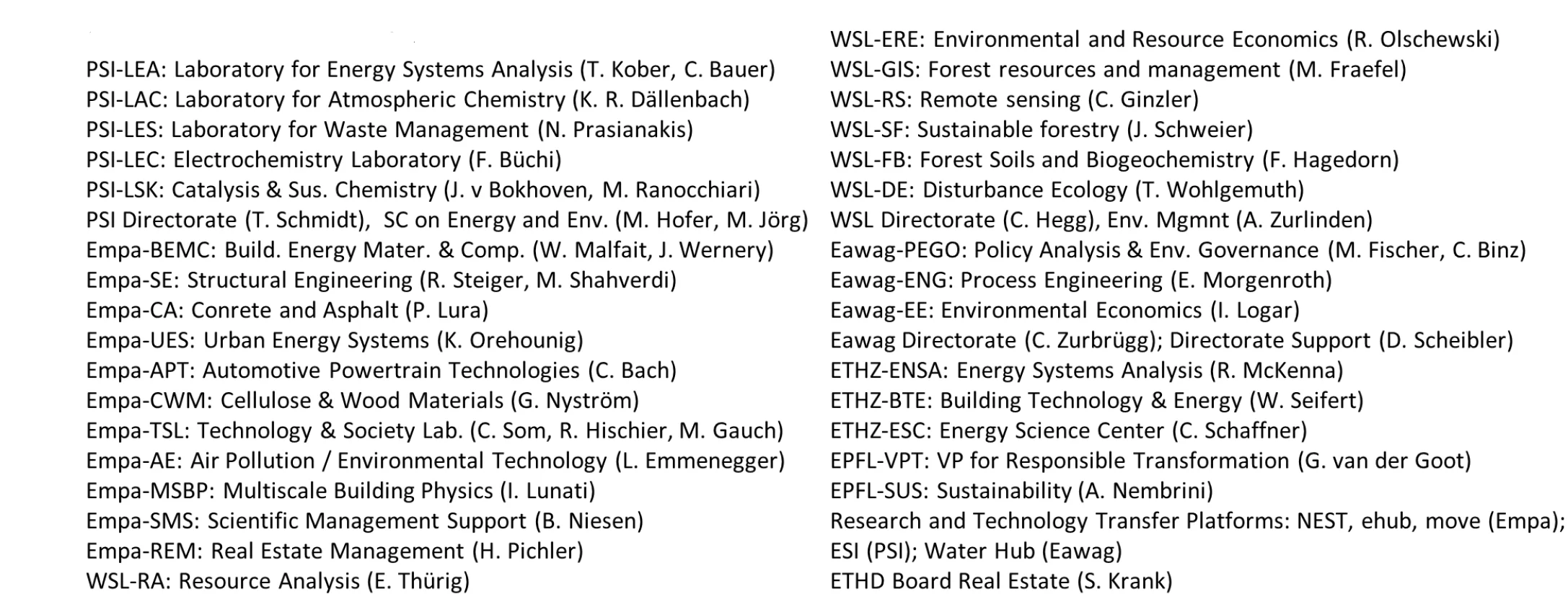Following an integrative and transdisciplinary approach, we have established a Center of Excellence covering the complete net-zero topical scope. This center builds on the tremendous expertise of the four research institutes of the ETH Domain (PSI, Empa, WSL & Eawag) and includes experts from ETH Zurich and EPFL.
The Center of Excellence offers an inter-institutional collaboration framework. It combines bottom-up organization with top-down strategic guidance, shared goals, and targeted communication with stakeholders for maximal impact.
Involved laboratories and Actors
Action Areas
1. Biomass carbon cycle
Currently, only a portion of the domestic wood resources is used sustainably in Switzerland. The wood processing industry has been shrinking substantially, and much of the harvested wood is exported or directly burned for energy supply. Although currently economically reasonable, this is not the best solution from a climate point of view.
Favoring "material before energy" seems to be a promising alternative, which optimizes the role of wood as long-term carbon sink.
The aims of this Action Area are to analyze, quantify and compare the effects of different forest management, wood use, and substitution scenarios on the greenhouse gas balance and investigate their associated impacts on climate change.
2. Technical carbon capture, utilization and sequestration
Achieving the net-zero emission goal requires CO2 removal from the atmosphere to compensate for residual emissions. Seasonal mismatch of renewable energy supply and demand must be balanced.
We propose a carbon-negative process chain including synthetic methane production, its pyrolysis, and long-term storage of resulting solid carbon. We leverage the storability/transportability of CH4 to decouple electricity generation from consumption.
The integrated cycle offers the following synergies:
- Integrated sorbents allow tuneable co-adsorption of CO2 and H2O to meet input requirements for co-electrolysis.
- The methane pyrolysis/decomposition process optimized for both energy efficiency and carbon quality ensures compatibility with use and storage.
The performance (LCA/LCC) and acceptance of the entire process chain will be assessed for spatial vs. seasonal decoupling to aid decision makers and provide a scientific basis for future implementation/investments.¨
3. Efficient Technical Cycles
The construction sector causes about 30% of the Swiss CO2 emissions and is therefore a primary target in the transition to circular, net-zero processes. In this sector, where CO2-heavy and high-volume construction materials such as concrete, steel, and asphalt are commonly used, solutions towards net-zero are still in their infancy and require an integrated transdisciplinary approach.
4. Flexible low-carbon energy systems
The future decarbonized energy system is expected to increasingly rely on electricity. This will require advanced flexibility mechanisms along the entire electricity supply chain as well as new technical solutions outside the electricity sector. Seasonal energy storage and demand-side flexibility measures that are acceptable to the consumers are needed to reduce stress on the power system.
We analyse the coordinated deployment of flexibility options in light of the 2050 net-zero emissions target on Swiss national and local/regional scales. The competences of several established modelling teams of the ETH Domain are combined to perform an integrated model-based scenario analysis.
Beyond techno-economic modelling, socio-economic research is used to investigate the preferences of consumers for new energy supply systems and the feasibility of demand-side flexibility options.
Technology roadmaps and geo-spatially detailed maps of flexibility mechanisms will inform decision makers, stakeholders, and citizens about necessary future investments and technology prospects for a carbon-free Swiss energy system.
5. Greenhouse gases & climate
We address the need for an integrated assessment of all greenhouse gas (GHG) emissions and their mitigation pathways across all sectors of the economy, while also considering their broader environmental and human impacts.
This Action Area is comprised of two major pillars:
The first pillar is the integrated modelling of GHG mitigation pathways, which deals with a techno-economic representation of the GHG emitting entities in Switzerland, their systemic interdependencies, and potential mitigation options. The well-established Swiss TIMES Energy system Model (STEM) is being expanded and interfaced with quantitative satellite tools. This allows us to incorporate novel datasets and state-of-the-art analytical approaches (e.g. as used for Switzerland’s emissions reporting to the UNFCCC) and mitigation measures (including negative emission measures). This will lead to a unique and advanced integrated modelling framework with which a scenario analysis aiming at net-zero GHG emissions by 2050 is performed.
The results from the first pillar feed into the second pillar, in which air pollutants and their dispersion are assessed at a high spatial resolution, and consequently the monetisation is quantified using an external cost approach. Ultimately, the assessment of external costs is combined with the system cost assessment derived from the techno-economic optimisation of emission mitigation pathways, which translates into the quantification of the total costs associated with reaching net-zero in Switzerland.
6. Net-zero institute roadmap
A working group comprised of researchers, sustainability officers, and members of the operations/infrastructure management from each institute has come together to enable an efficient inter-institutional and cross-disciplinary exchange. The goal of this collaboration is to define the institutions’ pathways to net-zero and the appropriate methodology to track progress.
At the outset, the group collects data to capture the current status and defines the target status for each institution. The development of the roadmap involves considerations about the necessary measures to take and their impacts, looking at various energy scenarios with cost developments, and performing investment cost calculations.
The group looks for synergies with the Research and Technology Transfer Platforms (RTTPs) at Empa, PSI and Eawag including NEST, the Energy Hub, ESI, and the Water Hub.
As a main outcome, a science-based roadmap towards net-zero will lay the basis for internal consensus and the necessary decisions.



